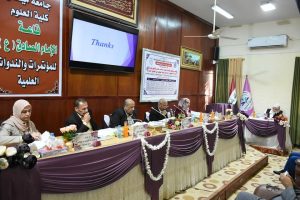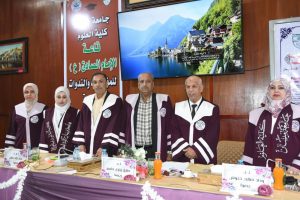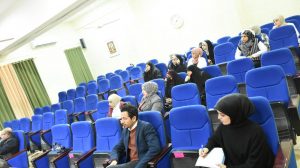A master’s thesis was discussed in the College of Science / University of Misan, entitled:
Preparation and characterization of nano-iron oxide-doped polymers and the study of
their analytical efficiency in removing some element ions from aqueous solutions. By
student Nour Sabah Kazim. The study aimed to Preparation of superparamagnetic nano-
iron oxide by co-precipitation method, then prepare nanocomposites from them with
different mixing ratios (1:1), (2:1), ((1:2) with polyurethane PU1 and with polyurethane
PU2 and using them as effective adsorbent surfaces to remove heavy metal ions. The best
mixing ratio was chosen after conducting the current study. The study also aimed to
characterize polymeric adsorbents using several techniques: Fourier Transform Infrared
spectroscopy FTIR, Atomic Absorption Spectroscopy (AAS), X-rays diffraction (XRD),
Field-Emission Scanning Electron Microscopy (FESEM) with dispersive X-ray detector.
EDX and transmission electron microscopy (TEM), Zeta potential. The study showed
that the adsorption process of ions, Cr (III), Pb (II) Ni (II), Co (II), and Cd (II) on the two
surfaces (Fe3O4-PU1 ), (Fe3O4-PU2) reach equilibrium at time intervals estimated at
(60,120,45,30,60 min).
In the case of temperature, the measured heat of metal ions Pb (II), Cr (III), Cd (II), Co
(II), (Ni (II) in this study is at temperatures (300, 303, 310, 318,325 K). , 333) and the
adsorption process is appropriate at low temperatures and high concentrations. The
results also showed that Langmuir model is applicable to Cd(II), and Co(II) elements,
where this model is highly applicable to the first mixture (Fe3O4-PU1). Pb(II), Cr(III),
and Ni(II) are highly applicable to the Freundlich model for this mixture. The elements
Co (II), Cr (III), and Ni (II) are highly applicable to the Langmuir model, and this means
that they are chemically adsorbent, as indicated in the results. – PU1: >Pb (II) Ni (II) Cd
(II) > Cr (III) > Co (II) > qmax adsorption quantity of the second mixture (Fe3O4- PU2):
Cd (II) > Cr (III) > Ni(II)Pb(II) > Co(II) >.
The discussion committee consisted of:
- Prof. Dr. Tariq Zubari Jassim, University of Basra, President.
- Prof. Dr. Widad Saleh Hanoush, University of Basra, Member.
- Ass.Prof. Dr. Ali Taha Saleh, University of Misan, member.
- Ass. Prof. Dr. Nisreen Abdel-Karim Abdel-Alali, University of Misan, as a member and
supervisor. - Ass.Prof. Hind Mahdi Saleh, University of Misan, member and supervisor.
On this occasion, Prof. Dr. Sabih Jassim Gatea, Dean of the College, met the discussion
committee in his office, thanking the efforts they made by taking the trouble to travel in
order to exchange scientific experiences in discussing master's theses, praising their
efforts in a letter of thanks and appreciation.


